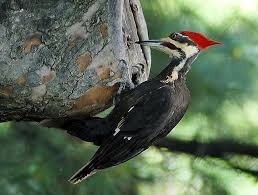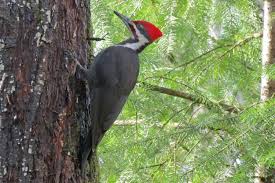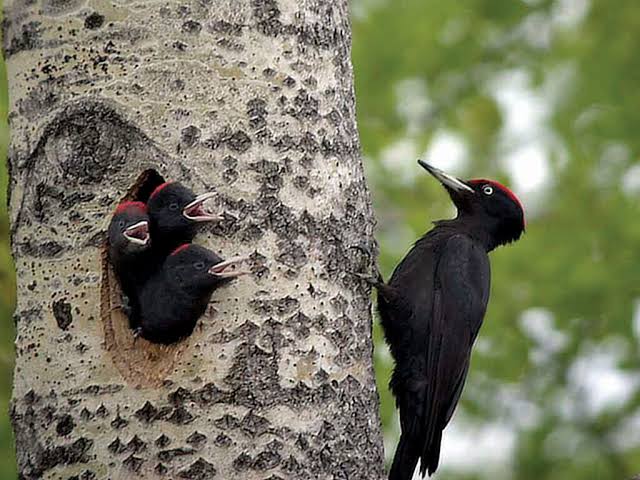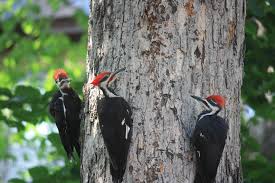Woodpeckers, scientifically known as Picidae, are fascinating birds that captivate the attention with their unique behaviors and distinctive characteristics. These birds belong to the Piciformes order and are widely distributed across various ecosystems, from dense forests to urban environments.
Woodpeckers are renowned for their exceptional ability to drum on trees using their strong, chisel-shaped bills. This behavior serves multiple purposes, such as establishing territory, attracting mates, and locating insects within the bark. The specialized structure of their skulls and beaks enables them to withstand the intense forces generated during rapid drumming without sustaining brain or beak injuries.
These birds exhibit a diverse range of sizes, colors, and patterns. Some woodpeckers, like the striking Pileated Woodpecker, boast vibrant plumage with distinctive red crests, while others, such as the Downy Woodpecker, display a more subdued black-and-white palette. This diversity in appearance allows woodpecker species to adapt to various habitats and niches.
One remarkable aspect of woodpecker biology is their tongue. Unlike most bird species, woodpeckers possess a long, barbed tongue that extends far beyond their bills. This specialized tongue is equipped with a glue-like substance to capture and extract insects from crevices in the wood. The tongue, combined with the woodpecker’s strong beak, makes them highly efficient hunters of insects and larvae.
Woodpeckers are integral to ecosystem health as they play a crucial role in controlling insect populations. By foraging on tree trunks and branches, they help prevent the spread of pests that can harm trees. Additionally, their excavation of nest cavities benefits other cavity-nesting species, as these sites are often reused by various birds for shelter and breeding.
Observing woodpeckers in their natural habitat provides a glimpse into their intricate social behaviors. These birds communicate through a variety of calls, drumming patterns, and body language. The communication serves purposes such as maintaining social bonds, signaling alarm, and coordinating breeding activities.
Despite their adaptability, woodpeckers face challenges in the modern world. Habitat loss, deforestation, and climate change threaten their natural environments. Some species may also collide with man-made structures, like buildings and utility poles, resulting in injuries.
Efforts to conserve woodpecker populations include habitat preservation, creating wildlife corridors, and raising awareness about the importance of these birds in maintaining ecological balance. Citizen science initiatives, where individuals contribute observations and data, also play a vital role in understanding woodpecker populations and their behaviors.
However, woodpeckers, scientifically known as Picidae, are remarkable birds with unique adaptations that enable them to thrive in various environments. From their drumming behaviors to specialized tongues and vibrant plumage, these birds contribute significantly to the ecosystems they inhabit. As stewards of our environment, it is crucial to appreciate and actively work towards the conservation of these captivating and ecologically important birds.
Read Also: Economic Importance and Uses of Turkey Meat
Animals and Plants Affected by Woodpeckers (Picidae)

Woodpeckers, while playing a crucial role in maintaining ecological balance, can have both direct and indirect effects on other organisms within their habitats.
1. Insects: Woodpeckers are skilled insect hunters, primarily targeting wood-boring insects and larvae. While this is beneficial for controlling insect populations and preventing tree damage, it can have a direct impact on insect species that serve as their prey. The presence of woodpeckers helps regulate insect numbers, affecting the dynamics of insect populations in their habitats.
2. Trees:.The drilling and excavating activities of woodpeckers can impact trees, both positively and negatively. While they help control insect pests that may harm trees, their extensive drumming and cavity excavation can cause damage to the bark and wood. This can make trees more susceptible to diseases and infections.
3. Other Bird Species: Woodpeckers create nesting cavities in trees, and after they abandon these sites, other bird species, such as nuthatches, chickadees, and small owls, may use these cavities for nesting. Therefore, the actions of woodpeckers indirectly provide nesting opportunities for a variety of bird species.
4. Competition with Other Woodpeckers: In areas with multiple woodpecker species, there can be competition for resources such as suitable nesting sites and foraging territories. Different woodpecker species may exhibit competitive interactions, influencing the distribution and abundance of each species in a given habitat.
5. Interaction with Man-Made Structures: Woodpeckers sometimes drum on man-made structures, including buildings and utility poles. While this behavior is part of their natural repertoire, it can lead to conflicts with humans, especially when the drumming causes damage to structures. This interaction can result in efforts to deter woodpeckers from specific areas.
6. Influence on Tree Health: While woodpeckers help control insect pests that may harm trees, their actions can also contribute to tree stress. The repeated drumming and excavation can weaken trees, especially if they are already under stress from other factors such as environmental changes or disease.
Understanding the intricate relationships between woodpeckers and their environment is crucial for effective conservation and management strategies. While these birds positively contribute to pest control and provide nesting opportunities for other species, their activities can also have implications for certain organisms and ecosystems. Balancing the conservation of woodpecker populations with the protection of vulnerable species and ecosystems remains an ongoing challenge in wildlife management.
Damages Caused by Woodpeckers

Woodpeckers, despite their beneficial roles in controlling insect populations, can sometimes cause damage that may be undesirable, particularly in certain human-altered environments. Here are some common damages associated with woodpecker activities:
1. Structural Damage: Woodpeckers may drum on various surfaces, including wooden siding, shingles, and utility poles. This repetitive drumming can lead to structural damage, causing holes or indentations in the material. Buildings with wooden components are especially vulnerable to this type of damage.
2. Paint and Finish Removal: The vigorous pecking and drumming by woodpeckers can result in the removal of paint, stain, or other finishes on structures. This not only compromises the aesthetics of buildings but also exposes underlying materials to the elements, potentially leading to further deterioration.
3. Nest Cavity Creation: While the creation of nesting cavities is a natural behavior for woodpeckers, it can be problematic when they choose inappropriate structures, such as wooden siding or eaves of buildings, for nesting sites. The excavation process can weaken the structural integrity of these surfaces.
4. Noise Disturbance: Woodpeckers can be noisy, especially during their drumming activities. In urban or residential areas, the loud drumming sounds can be a source of disturbance, impacting the quality of life for residents. This noise can be particularly problematic when woodpeckers choose structures near human habitation for drumming.
5. Attraction of Pests: The holes created by woodpeckers may attract other unwanted pests, such as insects or rodents, seeking shelter in the cavities. This can indirectly contribute to property damage and create additional challenges for homeowners.
6. Interference with Communication Equipment: In some cases, woodpeckers may drum on utility poles or communication equipment. This can lead to disruptions in signals or interfere with the functionality of these structures, posing challenges for utilities and telecommunication companies.
7. Impact on Certain Tree Species: While woodpeckers play a beneficial role in controlling insect pests in trees, their drilling activities can still have negative consequences for certain tree species. Weakened trees may become more susceptible to diseases or infestations by other pests.
Efforts to mitigate the damages caused by woodpeckers often involve implementing humane deterrents, such as visual or auditory deterrents, netting, or applying taste aversions to surfaces. Balancing the need to protect structures with the conservation of woodpecker populations is crucial, and understanding the reasons behind woodpecker behavior can guide effective and ethical management strategies.
Read Also: Economic Importance and Uses of Hen Eggs
Control and Preventive Measures

Controlling and preventing damages caused by woodpeckers involves a combination of understanding their behavior and implementing humane deterrents. Here are some effective control and preventive measures:
1. Visual Deterrents: Utilize visual deterrents, such as reflective tape, shiny objects, or scare balloons near areas where woodpeckers are causing damage. The movement and reflection of light can discourage woodpeckers from approaching and drumming on structures.
2. Auditory Deterrents: Implement auditory deterrents, such as devices that emit distress calls of woodpeckers or predatory bird sounds. These sounds can create an unwelcome environment for woodpeckers, encouraging them to avoid the area.
3. Netting: Install plastic or nylon netting over vulnerable surfaces to physically prevent woodpeckers from accessing and damaging those areas. Ensure that the netting is secured tightly to avoid any entanglement or harm to the birds.
4. Taste Aversions: Apply non-toxic taste aversion sprays or coatings on surfaces where woodpeckers are causing damage. These substances have a bitter taste, deterring the birds from pecking or drumming on treated surfaces.
5. Nesting Boxes: Provide alternative nesting sites by installing woodpecker nesting boxes at a safe distance from structures. This can redirect their natural behavior away from buildings while still offering suitable nesting opportunities.
6. Identify and Remove Insects: Since woodpeckers often drum to locate insects within wood, addressing the insect infestation may reduce their attraction to specific areas. Implement pest control measures to eliminate wood-boring insects and larvae from trees or wooden structures.
7. Habitat Modification: Make modifications to the habitat that discourage woodpeckers. This can include removing dead trees or snags, which are attractive to woodpeckers for nesting. Trimming branches that provide access to structures may also be effective.
8. Repellents: Consider using bird-safe repellents, such as sticky gels or sprays, on surfaces where woodpeckers are causing damage. These repellents create a sticky surface that woodpeckers find unpleasant, deterring them from drumming on treated areas.
9. Professional Assistance: If woodpecker damage is extensive or persistent, seek professional assistance. Wildlife experts or pest control professionals can assess the situation and provide customized solutions that balance effective control with the conservation of woodpecker populations.
It’s important to note that all deterrent methods should be humane and comply with local wildlife regulations. Avoid harmful or lethal measures, as woodpeckers are protected by laws in many regions. Additionally, combining multiple strategies may enhance their effectiveness, as woodpeckers can adapt to single deterrent methods over time. Regular monitoring and adjustment of preventive measures may be necessary to ensure long-term success.
Frequently Asked Questions (FAQs) About Woodpeckers (Picidae)
1. Q: What is the scientific name of woodpeckers?
A: Woodpeckers belong to the family Picidae, and their scientific name is Picidae.
2. Q: Why do woodpeckers drum on trees?
A: Woodpeckers drum on trees primarily for communication purposes, including establishing territory, attracting mates, and locating insects within the bark for feeding.
3. Q: Do woodpeckers only eat insects?
A: While insects are a significant part of their diet, woodpeckers also consume fruits, nuts, sap, and occasionally small vertebrates.
4. Q: How do woodpeckers avoid brain injury when drumming?
A: Woodpeckers have specialized adaptations, including a strong skull and a unique hyoid bone structure, which help dissipate the intense forces generated during rapid drumming, preventing brain injury.
5. Q: Do woodpeckers damage trees?
A: While their drumming and nest excavation can create holes in trees, woodpeckers also play a crucial role in controlling insect pests that can harm trees, contributing to overall forest health.
6. Q: Why do woodpeckers drum on man-made structures?
A: Woodpeckers may drum on man-made structures to establish territory, attract mates, or search for insects. However, this behavior can lead to structural damage.
7. Q: How can I deter woodpeckers from damaging my house?
A: Deterrents include visual and auditory methods, netting, taste aversions, providing alternative nesting boxes, and habitat modifications. It’s crucial to use humane and bird-safe deterrents.
8. Q: Are woodpeckers protected by law?
A: Yes, many woodpecker species are protected by wildlife conservation laws. It’s essential to check local regulations before implementing any control measures.
9. Q: Do woodpeckers migrate?
A: While some woodpecker species are migratory, others are resident and stay in their habitats throughout the year. Migration patterns vary among different species.
10. Q: Can woodpeckers cause damage to utility poles?
A: Yes, woodpeckers may drum on utility poles, causing damage. This behavior can lead to concerns about potential interference with communication equipment.
11. Q: What is the lifespan of woodpeckers?
A: The lifespan of woodpeckers varies by species. On average, many woodpeckers live 4 to 12 years, depending on factors such as size, habitat, and environmental conditions.
12. Q: Do woodpeckers have predators?
A: Yes, woodpeckers face predation from various animals, including larger birds of prey, snakes, and mammals. Nestlings and fledglings are especially vulnerable to predation.

